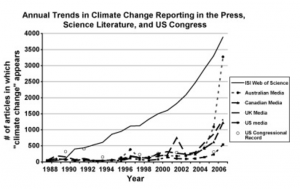Tipping Points in Climate Change Discourse
Link to Journal Article: http://www.sciencedirect.com/science/article/pii/S095937800900034X
Gladwell (2000) describes the concept of the tipping point as a specific time during an epidemic that leads to a steep change in a social trend or behavior. This change often occurs at an initial threshold value, from where the sudden change can go in both desirable and unwanted directions. The idea of tipping point is applicable to the discussion of climate change discourse, specifically in the early 2000s. The media mentions and literature study of climate change was increasing in the developed nations, but at a slow pace. However, in 2005, as can be seen in Figure 1, James Hansen’s (often called the Father of Climate Change) warnings regarding the severity of climate change, perhaps caused both media mentions and science literature of climate change to rise steeply between 2005 and 2006. Based on Gladwell’s (2000) theoretical concept of tipping points, it can be said that 2005 acts as a tipping point in time, that is the threshold value that leads to sudden change. From here, climate change discourse seems to become viral, as can be inferred from the figure below.
Figure 1 (Source: http://www.sciencedirect.com/science/article/pii/S095937800900034X)
The assumptions of tipping point for climate change discourse can further be explained using the economic concept of tipping points discussed in lecture. As shown in Figure 2, the popularity of climate change among media and scientists can be compared with the market for a new product that is trying to break into the market. Here, the price p can represent media and scientists’ costs related to climate change mentions and/or research. Values of z can represent the prevalence of climate change discourse at a given time.

Figure 2: Graph showing tipping point equilibria for a given product
Based on the aforementioned assumptions, the blue curve suggests that for any point below z’, media and researchers do not find value in climate change, which can cause its discourse to eventually fall to 0. For any point between z’ and z’’, media and research are willing to put in more time into climate action (values above cost p), thus increasing discourse over time to z’’. So, z’ essentially functions as a tipping point, from where climate change discourse can either rise to z’’ or fall to 0.
In the early 2000s, it can be said that the prevalence of climate change in media and science literature was at z. Hansen’s warnings in 2005 perhaps caused to z to leap to its tipping point z’ that further led to a virality of climate change in media and science, moving z closer to z’’. However, if there comes a point where critics of climate change create negative opinions (political causes for instance) for climate action, z could fall temporarily. As long as it does not fall at or below the tipping point, the prevalence of climate change discourse is likely to keep increasing with time.
The discussion above shows that the relevance of climate change in the media and science can be explained by drawing a parallel to the launch of a new product in the market. A powerful initial step: Hansen’s published research in the case of climate change and a successful marketing campaign in case of a new product, is crucial in reaching the threshold value (tipping point) to ensure growth over time.

